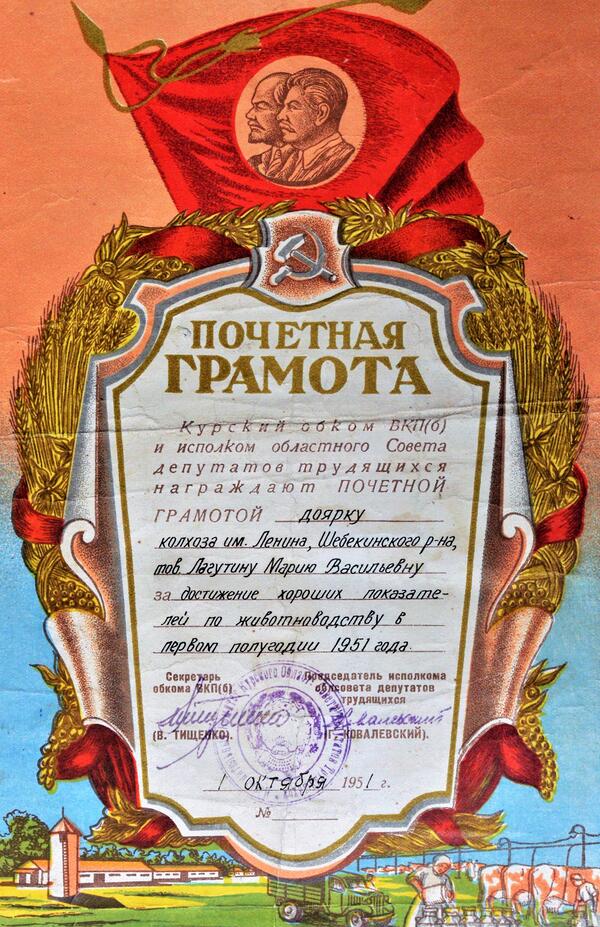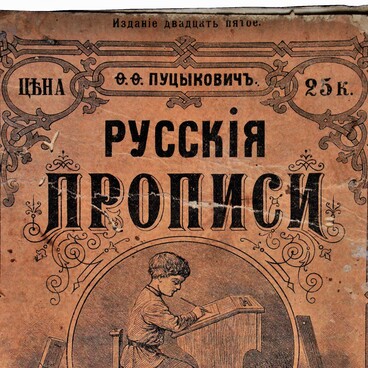The Shebekino History and Art Museum houses a Letter of Commendation of a local resident Maria Lagutina. She was a milkmaid of the collective farm named after V.I. Lenin in the Koshlakovsky Rural Soviet of the Shebekino district. In 1950, Maria Lagutina produced 4,500 liters of milk that made 370 pails from each cow. For this, she received a Letter of Commendation with the wording “for the achievement of high performance in cattle breeding”.
Two years later Maria Lagutina’s brochure “How we achieve high milk yield: The story of a milkmaid of the collective farm named after Lenin of the Shebekino district” was published. In 1955, the milkmaid from Shebekino was invited to the All-Union Agricultural Exhibition in Moscow, where she was awarded a Great Silver Medal and received a radio set as a memento.
Agriculture in the Shebekino district was one of the most developed in the Belgorod Region. During the Great Patriotic War, a significant part of the area was besieged for almost two years. Consequently, rehabilitation of agrarian production was the main goal after receiving freedom Most of the fields turned out to be unsuitable for growing crops: the area was pitted with trenches, dugouts, bomb and shell craters, and there were mines too. Moreover, the region ran short of machinery, tools, and manpower: many men did not come back from the war.
As far back as February 1943, the locals started reviving agriculture. In the spring of the next year, 16 thousand hectares were sown by sugar beet and wheat.
By 1948, 6 new pig-breeding farms and 21 poultry farms were established in the Shebekino district. Two years later, an incubator-poultry station was built. The best collective farm members were motivated by Letters of Commendation and mementos, they were awarded orders and medals. In addition, their photographs were displayed on the Honor Boards.
The collective farm named after V.I. Lenin, where Maria Lagutina worked, was one of the largest and progressive ones in the Shebekino district. It included several neighboring villages’ farms: Krapivnoe, Koshlakovo, Churaevo, and others. There were many outstanding workers among the collective farm employees, who had received Letters of Commendation and medals.
Two years later Maria Lagutina’s brochure “How we achieve high milk yield: The story of a milkmaid of the collective farm named after Lenin of the Shebekino district” was published. In 1955, the milkmaid from Shebekino was invited to the All-Union Agricultural Exhibition in Moscow, where she was awarded a Great Silver Medal and received a radio set as a memento.
Agriculture in the Shebekino district was one of the most developed in the Belgorod Region. During the Great Patriotic War, a significant part of the area was besieged for almost two years. Consequently, rehabilitation of agrarian production was the main goal after receiving freedom Most of the fields turned out to be unsuitable for growing crops: the area was pitted with trenches, dugouts, bomb and shell craters, and there were mines too. Moreover, the region ran short of machinery, tools, and manpower: many men did not come back from the war.
As far back as February 1943, the locals started reviving agriculture. In the spring of the next year, 16 thousand hectares were sown by sugar beet and wheat.
By 1948, 6 new pig-breeding farms and 21 poultry farms were established in the Shebekino district. Two years later, an incubator-poultry station was built. The best collective farm members were motivated by Letters of Commendation and mementos, they were awarded orders and medals. In addition, their photographs were displayed on the Honor Boards.
The collective farm named after V.I. Lenin, where Maria Lagutina worked, was one of the largest and progressive ones in the Shebekino district. It included several neighboring villages’ farms: Krapivnoe, Koshlakovo, Churaevo, and others. There were many outstanding workers among the collective farm employees, who had received Letters of Commendation and medals.



